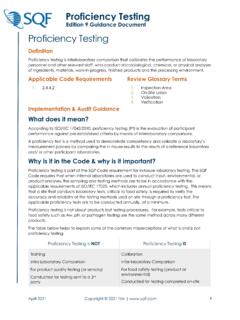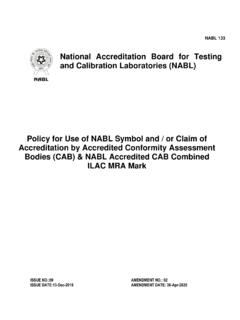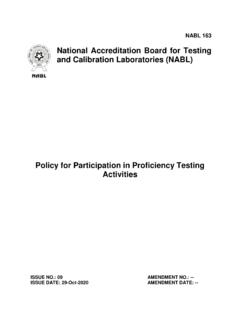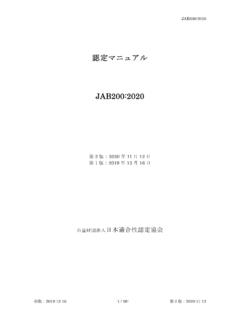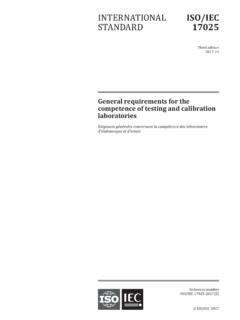Transcription of INTERNATIONAL ISO STANDARD 13528
1 ISO 2015 Statistical methods for use in proficiency testing by interlaboratory comparisonM thodes statistiques utilis es dans les essais d aptitude par comparaison interlaboratoiresINTERNATIONAL STANDAR DISO13528 Second edition2015-08-01 Reference numberISO 13528 :2015(E) ISO 13528 :2015(E) ii ISO 2015 All rights reservedCOPYRIGHT PROTECTED DOCUMENT ISO 2015, Published in SwitzerlandAll rights reserved. Unless otherwise specified, no part of this publication may be reproduced or utilized otherwise in any form or by any means, electronic or mechanical, including photocopying, or posting on the internet or an intranet, without prior written permission. Permission can be requested from either ISO at the address below or ISO s member body in the country of the copyright officeCh. de Blandonnet 8 CP 401CH-1214 Vernier, Geneva, SwitzerlandTel.
2 +41 22 749 01 11 Fax +41 22 749 09 ISO 13528 :2015(E) Foreword ..v0 Introduction ..vi1 Scope ..12 Normative references ..13 Terms and definitions ..14 General principles .. General requirements for statistical methods .. Basic model .. General approaches for the evaluation of performance ..55 Guidelines for the statistical design of proficiency testing schemes .. Introduction to the statistical design of proficiency testing schemes .. Basis of a statistical design .. Considerations for the statistical distribution of results .. Considerations for small numbers of participants .. Guidelines for choosing the reporting Guidelines for the initial review of proficiency testing items and results .. Homogeneity and stability of proficiency test Considerations for different measurement methods.
3 Blunder removal .. Visual review of data .. Robust statistical methods .. Outlier techniques for individual Determination of the assigned value and its STANDARD uncertainty .. Choice of method of determining the assigned Determining the uncertainty of the assigned value .. Formulation .. Certified reference Results from one laboratory .. Consensus value from expert laboratories .. Consensus value from participant results .. Comparison of the assigned value with an independent reference value ..198 Determination of criteria for evaluation of performance .. Approaches for determining evaluation criteria .. By perception of experts .. By experience from previous rounds of a proficiency testing scheme .. By use of a general model .. Using the repeatability and reproducibility STANDARD deviations from a previous collaborative study of precision of a measurement method.
4 From data obtained in the same round of a proficiency testing scheme .. Monitoring interlaboratory agreement ..239 Calculation of performance statistics .. General considerations for determining performance .. Limiting the uncertainty of the assigned value .. Estimates of deviation (measurement error) .. z scores .. z scores .. Zeta scores ( ) .. En scores .. Evaluation of participant uncertainties in testing .. Combined performance scores ..30 ISO 2015 All rights reserved iiiContents Page ISO 13528 :2015(E) 10 Graphical methods for describing performance scores .. Application of graphical methods .. Histograms of results or performance scores .. Kernel density plots .. Bar-plots of standardized performance Youden Plot .. Plots of repeatability STANDARD deviations .. Split samples.
5 Graphical methods for combining performance scores over several rounds of a proficiency testing scheme ..3611 Design and analysis of qualitative proficiency testing schemes (including nominal and ordinal properties) .. Types of qualitative data .. Statistical design .. Assigned values for qualitative proficiency testing schemes .. Performance evaluation and scoring for qualitative proficiency testing A (normative) Symbols ..42 Annex B (normative) Homogeneity and stability of proficiency test items ..44 Annex C (normative) Robust analysis ..52 Annex D (informative) Additional Guidance on Statistical Procedures ..63 Annex E (informative) Illustrative Examples ..67 Bibliography ..89iv ISO 2015 All rights reserved ISO 13528 :2015(E)ForewordISO (the INTERNATIONAL Organization for Standardization) is a worldwide federation of national standards bodies (ISO member bodies).
6 The work of preparing INTERNATIONAL Standards is normally carried out through ISO technical committees. Each member body interested in a subject for which a technical committee has been established has the right to be represented on that committee. INTERNATIONAL organizations, governmental and non-governmental, in liaison with ISO, also take part in the work. ISO collaborates closely with the INTERNATIONAL Electrotechnical Commission (IEC) on all matters of electrotechnical procedures used to develop this document and those intended for its further maintenance are described in the ISO/IEC Directives, Part 1. In particular the different approval criteria needed for the different types of ISO documents should be noted. This document was drafted in accordance with the editorial rules of the ISO/IEC Directives, Part 2 (see ).
7 Attention is drawn to the possibility that some of the elements of this document may be the subject of patent rights. ISO shall not be held responsible for identifying any or all such patent rights. Details of any patent rights identified during the development of the document will be in the Introduction and/or on the ISO list of patent declarations received (see ).Any trade name used in this document is information given for the convenience of users and does not constitute an an explanation on the meaning of ISO specific terms and expressions related to conformity assessment, as well as information about ISO s adherence to the WTO principles in the Technical Barriers to Trade (TBT) see the following URL: Foreword - Supplementary informationThe committee responsible for this document is ISO/TC 69, Applications of statistical methods, Subcommittee SC 6, Measurement methods and second edition of ISO 13528 cancels and replaces the first edition (ISO 13528 :2005), of which it constitutes a technical revision.
8 This second edition provides changes to bring the document into harmony with ISO/ iec 17043 :2010, which replaced ISO Guide 43-1:1997. It follows a revised structure, to describe better the process of the design, analysis, and reporting of proficiency testing schemes. It also eliminates some procedures that are no longer considered to be appropriate, and adds or revises some other sections to be consistent with ISO/ iec 17043 and to provide clarity and correct minor errors. New sections have been added for qualitative data and additional robust statistical methods. ISO 2015 All rights reserved v ISO 13528 :2015(E)0 The purposes of proficiency testingProficiency testing involves the use of interlaboratory comparisons to determine the performance of participants (which may be laboratories, inspection bodies, or individuals) for specific tests or measurements, and to monitor their continuing performance.
9 There are a number of typical purposes of proficiency testing, as described in the Introduction to ISO/ iec 17043 :2010. These include the evaluation of laboratory performance, the identification of problems in laboratories, establishing effectiveness and comparability of test or measurement methods, the provision of additional confidence to laboratory customers, validation of uncertainty claims, and the education of participating laboratories. The statistical design and analytical techniques applied must be appropriate for the stated purpose(s). Rationale for scoring in proficiency testing schemesA variety of scoring strategies is available and in use for proficiency testing. Although the detailed calculations differ, most proficiency testing schemes compare the participant s deviation from an assigned value with a numerical criterion which is used to decide whether or not the deviation represents cause for concern.
10 The strategies used for value assignment and for choosing a criterion for assessment of the participant deviations are therefore critical. In particular, it is important to consider whether the assigned value and criterion for assessing deviations should be independent of participant results, or should be derived from the results submitted. In this STANDARD , both strategies are provided for. However, attention is drawn to the discussion that will be found in sections 7 and 8 of the advantages and disadvantages of choosing assigned values or criteria for assessing deviations that are not derived from the participant results. It will be seen that in general, choosing assigned values and assessment criteria independently of participant results offers advantages. This is particularly the case for the criterion used to assess deviations from the assigned value such as the STANDARD deviation for proficiency assessment or an allowance for measurement error for which a consistent choice based on suitability for a particular end use of the measurement results, is especially ISO 13528 and ISO/ iec 17043 ISO 13528 provides support for the implementation of ISO/ iec 17043 particularly, on the requirements for the statistical design, validation of proficiency test items, review of results, and reporting summary statistics.



